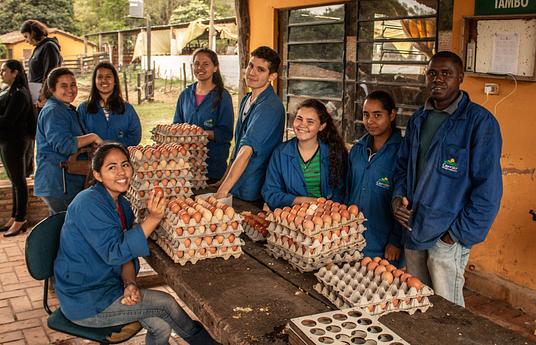For the past decade, the start of the academic day at Cornell High School begins with a familiar line, “We’ll see you in the halls.” It all started when two teachers decided to try to live stream our morning announcements. We had some old equipment that was previously used to broadcast through the school using old coax cable that desperately needed replacement. We didn’t have a studio or a budget to replace the equipment, but we were able to find a second-hand computer, a microphone, and a camera. A lot has changed with streaming video since then. With sites such as Twitter and YouTube, this is something you can easily start doing today!
Excitement is in the air each morning in a way that just doesn’t happen in a traditional class. Students rotate jobs such as producer, director, on-air talent, etc. Our program attracts a diverse team of students who are there because they are interested in broadcasting or learning to use a camera or new technology or who just want to tell a story. As Victoria, one of our freshmen puts it, "It's sometimes a disaster, but it's always a fun disaster. We always make it work somehow. It's fun to work in a fast paced environment."
CHS-TV has never been a class at Cornell. Our students give up their breakfast time to prepare and deliver a morning announcement program that includes all of the happenings at school along with lunch, weather, student-created commercials, and sports reports. We had really limited resources, especially in the beginning, so we had to rely on our students to identify causes of problems and finding the best resolutions. Our students have taken ownership of this project in a way that is really unique. They have developed an innovative mindset and are constantly tinkering with lighting, shots, graphics, and how the team is organized.
Over the years, the stories change to reflect the interests of our students. Several years back, our students produced a series called, "This Day in Pittsburgh History," with the help of The Thomas & Katherine Detre Library & Archives at the Senator John Heinz History Center and Steeltown Entertainment. More recently our students have been creating more personal stories through interviews of students and teachers in our high school.
Because of the success of the program, our students and teacher have developed relationships with outside organizations to help improve the broadcast. We have received countless grants to purchase computers, cameras, and microphones. The school built a dedicated space that is now used as a studio. We have a new journalism course that we have partnered with Point Park University and Steeltown Entertainment to offer. Steeltown sends a teaching artist two days each week and our students are able to earn three college credits.
Even though a lot has changed in the past ten years, new students, new teachers, and new tools. The culture in the studio has remained much the same. Our studio is a place where students can come and learn about broadcasting while learning a little bit about themselves. It is a safe place where they can take risks, express themselves, and learn to fail forward.



